The first time I heard about shortening was when an American colleague couldn’t find it for a recipe she planned to make for Thanksgiving dinner. When she served sweet potatoes covered with melted marshmallows, I wasn’t immediately inclined to adopt American cuisine and so forgot about shortening until somewhat recently. ![]()
I only came across it again when I got into cookie decorating and was comparing different recipes for sugar cookies. Admittedly, I skipped those that mentioned shortening, and I now use a recipe with only butter for the fat. But because shortening is used more liberally in America than in other countries, I was prompted to explore why that might be. What exactly is shortening, and does it have virtues I was unaware of?
What is Shortening?
As it turns out, it's not that hard to find out more about shortening. Early on, around about the 18th century, "shortening" referred generally to lard or other fats used in baking, the addition of which "shortens" gluten strands and makes baked goods more crumbly and delicate. By the beginning of the 20th century, hydrogenation (adding hydrogen atoms to molecules) was developed to turn vegetable oils into solid fats, primarily to lengthen shelf life and to create less expensive non-animal-based fats. The term "shortening" then became more commonly associated with these artificially hydrogenated products.
Aside: The hydrogenation process increases the melting point of the fat, and depending on the amount of hydrogenation, can turn the oil into a semi-solid (margarine and butter spreads) or a solid (vegetable shortening). The process also leaves shortening white and virtually tasteless, unless additives are introduced to make it look and taste more like butter.
A solid fat, like shortening, is generally preferable to oil for baking, as it "creams" better with sugar, leading to a finer, more aerated texture in baked goods. Compared to animal fats, shortening is also typically cheaper and has a longer shelf life, as noted above, and can be stored at room temperature. Yet, despite these advantages, shortening has historically gotten a bad rap for health reasons. Artificial hydrogenation turns an unsaturated fat into a less heart-healthy saturated fat, and can also introduce trans fats.
[EDITOR'S NOTE: This bad rap is becoming less grounded in truth. For instance, The J. M. Smucker Company, manufacturer of Crisco, introduced its first no trans-fat version in 2004. Its current formulation is marketed as having zero grams trans fat and 50 percent less saturated fat than butter. (Source: product label.) ADDENDUM: That said, despite the product labeling, it still does have a small amount of trans fat, as explained here.]
In short: "Shortening" typically refers to a solid white fat made from vegetable oils using the technique known as hydrogenation; margarine is semi-solid hydrogenated vegetable oil; and butter is solid animal-based fat. Coconut oil, which is often substituted for "shortening", is a plant-based fat that is solid in its natural state, and may or may not be artificially hydrogenated.
Shortening (and Other Solid Fats) Around the World
South Africa: The term "shortening" is not often used for products sold in retail outlets. Anything that is not butter is usually called margarine, be it a sandwich spread or a solid block of fat. Brand names for margarine include Marvello White, Wooden Spoon, Cordon Bleu, and Stork. Coconut oil is more readily available in stores. While I couldn't find any products called "shortening", it is apparently available through other channels, including brands such as Hilite (an animal-based shortening manufactured in Australia) and Holsum (solid palm oil).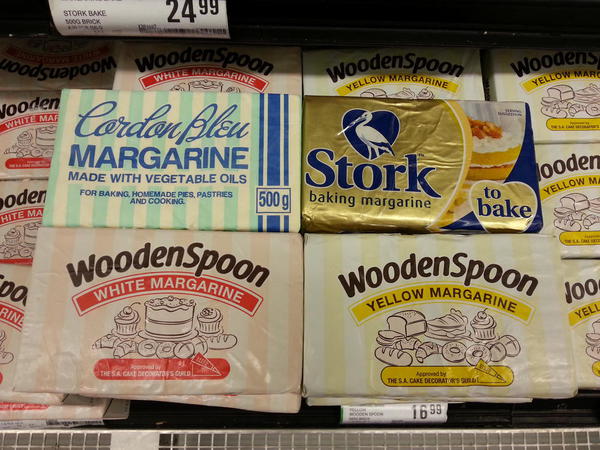
USA: "Shortening" is a commonly used term, and widely available in every grocery store. The most common brand I came across is Crisco (short for crystallized cottonseed oil). Earth Balance and Spectrum produce organic versions, usually available in high-end or specialty groceries. Shortening comes packaged in tubs, cans, and sticks.
Australia, New Zealand, France, and Germany: In Australia, Copha, made from artificially hydrogenated coconut oil, is the most common brand of shortening. In New Zealand, it is marketed as Kremelta; in France as VÉgÉtaline; and in Germany as Palmin.
England and Ireland: Though generally referred to as "vegetable fat", "refined vegetable fat", or "cooking fat", the most common brands of vegetable shortening in these parts are Trex, Flora White, and Cookeen.
Brazil: The most common brand is Mesa, which comes packaged in a plastic bag.
How Shortening Compares to Other Fats in Cookies
As I mentioned earlier, shortening has a higher melting point than other solid fats. Shortening typically melts between 111°F and 122°F (44°C - 50°C); margarine between 91°F and 109°F (33°C - 43°C); butter between 90°F and 95°F (32°C - 35°C); and natural non-hydrogenated coconut oil at about 76°F (24°C), though its melting point will be closer 97°F to 104°F (36°C - 40°C) if the oil is hydrogenated. A higher melting point means that flour and eggs can set more fully before the fat melts, thus reducing the likelihood of spreading.
Shortening makes shorter gluten strands in dough. This will also limit spreading and give a more crunchy texture to cookies, which got me wondering . . . Is shortening what makes other people’s cookies sometimes seem so white, or are their cookies just baked before the edges start colouring? Does the choice of shortening or butter influence the baking length?
Shortening and coconut oil are 100 percent fat, as opposed to butter (or margarine), which can contain 80 to 90 percent fat, with the rest being water. The water that gets introduced into dough by using butter (or margarine) can cause pockets of steam in cookies when baking and thus an uneven surface for decorating.
Colour- and flavor-wise, I don't think there's as much difference between shortening and butter any more, since anything and everything can get added to shortening to make it look/taste like butter.
An Experiment
To compare shortening and butter, I took Julia’s gingerbread recipe and made it with the “shortening” (aka margarine*) I could find in South Africa. I then made a second batch with butter substituted (one for one) for the margarine, and a third batch with non-hydrogenated coconut oil substituted (again, one for one) for the margarine. I expected that these replacements would not give the same result without adjusting the rest of the recipe as well, but I gave it a try to see the effect.
*Just a note: The margarines I could find have a fat content of 80 percent, similar to butter, and not 100 percent like "proper" shortening or coconut oil. The only differences between the Wooden Spoon and Cordon Bleu margarines (both from the same manufacturer) that I could find were the kind of oil used and the colourants.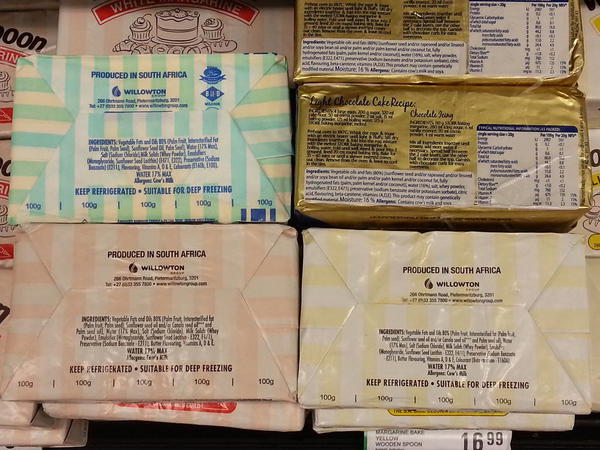
First, I tested the solidity of the three fats at room temperature (see photos, below). My finger just went down into the butter; I could make an imprint in the margarine, but the resistance made it well up along my finger; and I could not make an imprint in the coconut oil. When I pushed down harder, the piece broke!
Next, I evaluated the mixed dough. The butter dough stayed very soft even after having it in the fridge for a day. The other two were firmer when first mixed. When rolling out the cookies, the coconut oil dough was rather sticky.
Butter Tests
Margarine Tests
Coconut Oil Tests
During baking, the coconut oil dough kept its shape best, but the other two did not spread very noticeably. I could not notice any difference in taste, and only the slightest difference in texture in that the coconut oil cookies were slightly crunchier.
[EDITOR'S NOTE: It's interesting to me that the dough with non-hydrogenated coconut oil, the fat with the lowest melting point, held its shape best. But that fat also has the lowest water content of the three, so perhaps this is an indicator that higher water content has a greater effect on spreading and misshaping than fat content? Hmmm . . .]
Summary: In this baking session, with this recipe, there was not much difference among the three fats used. But do keep in mind that I did not use "proper" shortening, which has the highest melting point of all. It would be great if some of you could make a batch with butter and a batch with shortening, and let us know how the two compare in your kitchen!
Sources: Wikipedia, Associated Press, the kitchn, cooksinfo.com, Crisco website, other product labels and websites


Liesbet Schietecatte, born in Belgium but permanently living in South Africa since 2005, accidentally found her way into cookie decorating in 2012. Grabbing moments in between her career as an archaeologist and being a mommy and a wife, Liesbet bakes Belgian biscuits like speculoos in the tradition of her grandmother’s family who were bakers for several generations, but she gets the most creative satisfaction from decorating with royal icing. She bakes and decorates for occasional orders and at times for a crafters' market, but mostly for the enjoyment and challenge of trying out new things. To honour her family's baking legacy, Liesbet uses the family name to give a home to her baking pictures on Facebook: Stock’s – Belgian Artisan Bakes.
Photo credit: Liesbet Schietecatte
Note: Toolbox Talk is a bimonthly Cookie Connection blog feature written by Liesbet Schietecatte that explores similarities and differences in cookie tools and ingredients from all over the world. Its content expresses the views of the author and not necessarily those of this site, its owners, its administrators, or its employees. Catch up on all of Liesbet's past Cookie Connection posts here.

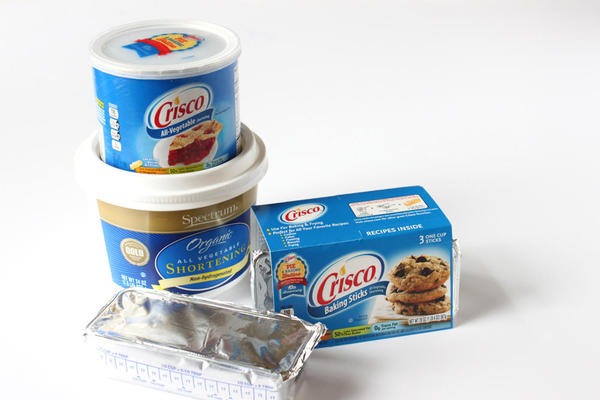
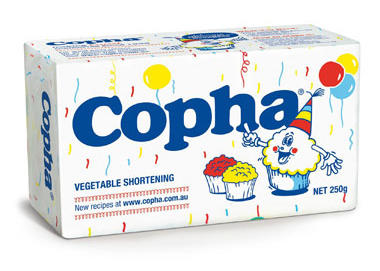



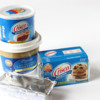



Comments (21)